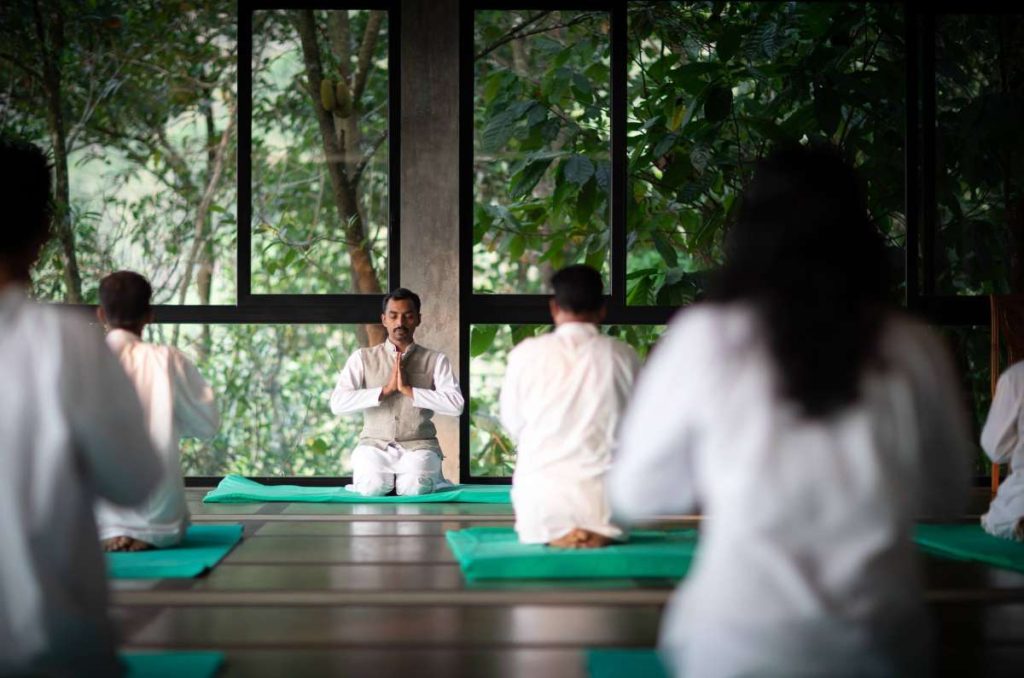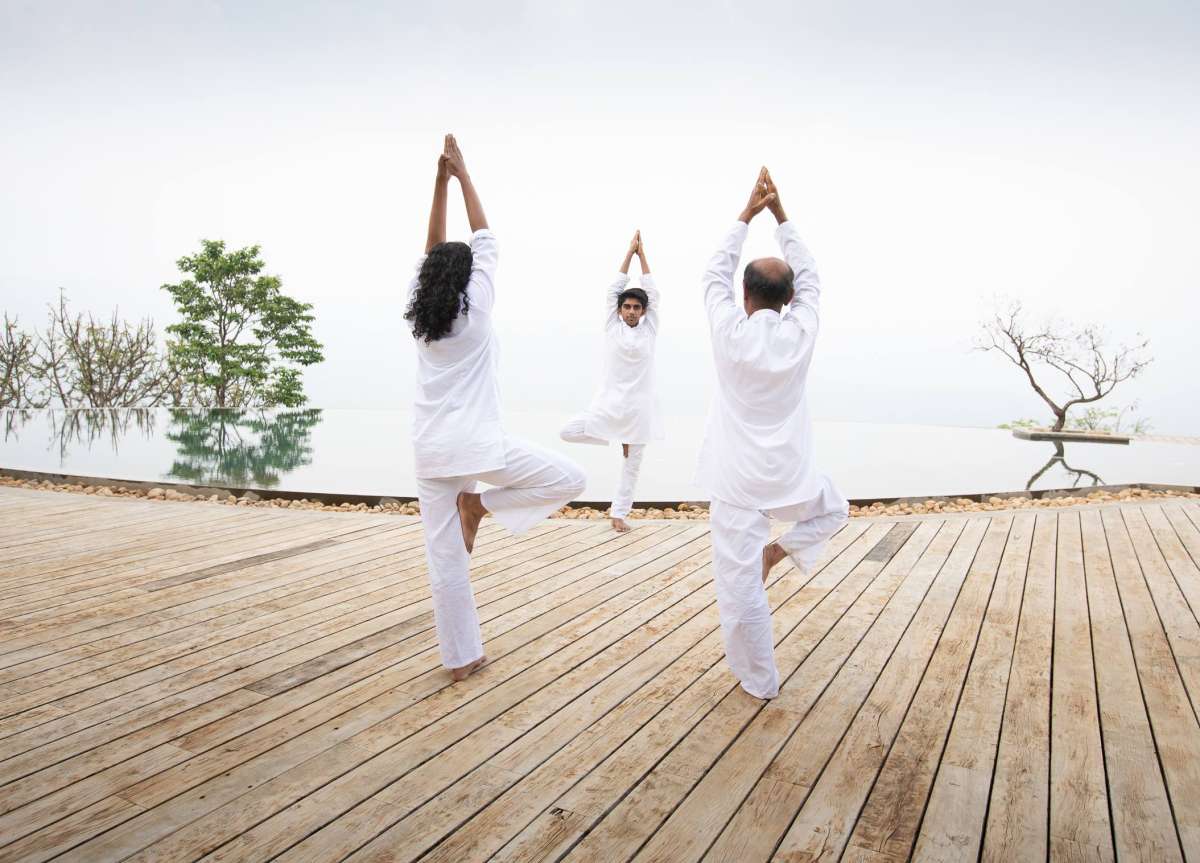Physical and mental therapy are one of yoga’s most important achievements. What makes it so powerful and effective is the fact that it works on the holistic principles of harmony and unification…reports Asian Lite News
Ever since its inception, international yoga day has been celebrated on June 21st throughout the world, and yoga has been recognised as an ancient practice that helps to improve the state of relaxation, improves the blood flow, enhances immunity and aids with mindfulness.
According to the Doctors at CGH Wellness Experiences
Yoga’s regulated rhythmic breathing strengthens the core diaphragmatic muscles, improves the cognitive functions, increasing the pain threshold, improves mood related problems am overall well proven that yoga can provide a healthy and fruitful life in all aspects.
Physical and mental therapy are one of yoga’s most important achievements. What makes it so powerful and effective is the fact that it works on the holistic principles of harmony and unification. Yoga has succeeded as an alternative form of therapy in conditions like obesity, asthma, diabetes, blood pressure, arthritis, digestive disorders, and other ailments of a chronic and constitutional nature, where modern science has not. Yoga therapy has been successful because of the balance created in the nervous and endocrine system which directly influences all the other systems and organs of the body.

How To Heal The Body Mind And Soul Through Yoga
According to Yoga literature, which has been well validated by science too, all lifestyle diseases are primarily rooted in the mind which in turn affects one’s energy and manifests in the body as symptoms of illness. Therefore, the healing process also needs to start from the mind itself and here yoga comes with a perfect solution for your Heath issues as it works not only on your mind but also on your energy and physical planes.
Yogic breathing:
Yogic breathing is a technique where inweuseourabdomen,chestandshoulders systematically. Expand your abdomen, chest and shoulder systematically while you inhale and relax your shoulders, chest and the abdomen while you exhale. This helps to make your breath slow, deep, calm and controlled while rhythmic.
Surya namaskar:
This is a combination of 12 steps with alternative forward and backward stretching. When practiced slowly with awareness, it helps to maintain balance in the hormonal and nervous system and brings harmony in the body.
Yogic Asanas:
Yoga ‘Asanas‘ are postures which involve stretching and maintaining it for a while. It helps to give movement to the muscles in our body; thereby aiding in providing nutrition even to the minor set of muscles in the body. It is always better including a variety of asanas, rather than practicing the same set of asanas daily. Asanas were never intended to be practiced rapidly or to be in conflict with the body. As traditional texts explain Yoga Asanas are about being in a state of stability and comfort.
Pranayama:
‘ Pranayama’is the systemic breathing methodology in Yoga to change the arrhythmic inhalations and exhalations into rhythmic , slow and steady. It helps to purify energy channels and to bring harmony to the physiological functions in the body. ‘Pranas’ are the Yogic concepts for the vital energy in the body and its rhythmic and harmonious flow is very crucial in keeping our body healthy and disease free.
Yoga Nidra:
There are scientific evidence shows that Yoga nidras and other meditation techniques have an impact in your health by neutralizing our emotional behaviors and stress. Regular practice of Yogic meditative techniques helps to calm down your mind and helps to make intellectual choices in deciding your lifestyle.

Understanding illness in a Yogic Way
Diseases of mankind originate from within the layers of the Mind and affects / disturbs the Energy Layer to manifest in the Physical layer as a disease or symptoms of one. In the Mind the imbalance starts as Likes &Dislikes which leads to emotional reactions. Emotions in turn lead to wrong actions which end up as wrong outcomes, that create Mental stress. This Mental stress is named as “Adhis’ (the primary disease but no symptom seen at the physical level). This causes an agitated body and mind. When the body and mind is agitated, it affects all the normal physiological functions of the body, especially the digestive system which leads to faulty digestion, non-digestion & over digestion of food eaten. This impairment in the digestive system causes the settling of improperly digested food(toxins)in the body which finally manifest as Vyadhi –Psychosomatic ailments.
Integrated Yoga Therapy
In the treatment of psychosomatic ailments, it is mandatory to work on the body and mind to bring about a complete cure. In integrated Yoga therapy, various Yoga modalities are used to treat the psychosomatic diseases.
For the Physical body:
Kriyas (Neti, Dhouthi, Nouli) ,sithilikarana vyayama, cultural and relaxative asanas.
For the mind:
Breathing exercises, pranayama, kriyas, Bendhas and Mudras, Dharana, Dhanya, Yoganidra.
General Instructions & point store member while Practicing Therapeutic Yoga
Always practice under the guidance of a qualified trainer.
Don’tcopypracticesprescribedforothers.Eventhoughthediseaseconditionmightbesame, therpeautic Yoga prescriptions are prescribed taking into account various factors like age, gender, general health, and co-morbidities.
Ifyoufeelanykindofunusualpainordiscomfortduringpractice,stopthepracticeimmediately and bring it to the notice of the doctor.
Don’t fight with your body–always know your limits.
Keep your awareness in the body and breath during the practice.
Loosening practices can be done dynamically but ensure to relax completely before the next practice.
Avoid yoga if you are suffering from a fever, after surgeries, in case spinal cord issues and hernia – seek expert guidance.
Practice on an empty stomach or alternately 3 hours after your last meal
Wear loose and comfortable attire
Use a comfortable yoga mat, which has a good grip
Do your practice in a place which has good air circulation
Don’t take bath immediately after your Yoga practice. Keep a minimum gap of 30 mints
If you feel any kind of unusual pain or discomfort during practice, stop the practice immediately and contact your trainer.
Always take adequate relaxation between each practice.
By default always breathe through your nose, unless instructed otherwise
Don’t practice general yoga during your menstrual cycle and pregnancy.
End the practice by relaxing in the Shavasana pose for 5 to 10 mins and let your breath , body temperature, muscles and heart beat return to normal.
ALSO READ-Let’s have a healthy digestive system



